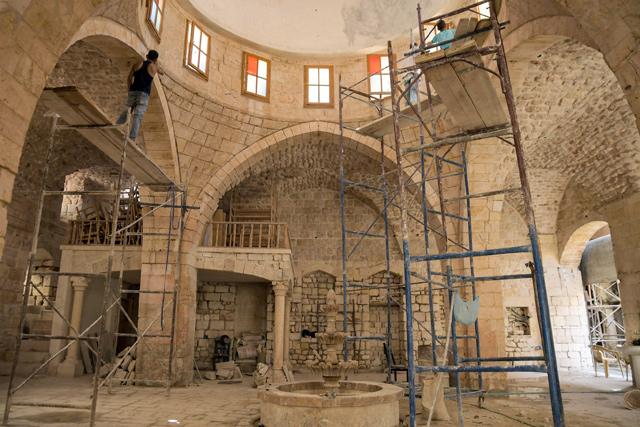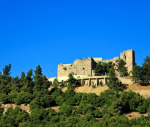You are here
In Syria's Homs, war-ravaged ancient market slowly reemerges
By AFP - Sep 08,2016 - Last updated at Sep 08,2016

A photo taken on August 14 shows an alley at the ancient market in the heart of the mostly government-controlled Syrian city of Homs (AFP photo)
HOMS, Syria — In the heart of the Syrian city of Homs, workers clear rubble and clean the blackened walls of the war-ravaged old market in a bid to restore its former glory.
Much of Homs lay in ruins when its Old City was recaptured from rebels by government troops in 2014 after a two-year siege and near-daily bombardment.
Now a UN-backed project is trying to restore the ancient souk, or market, in the central city, dubbed the "capital of the revolution" because of the enormous anti-regime protests that erupted there five years ago.
Near Clock Square, where the frontline ran during the fighting, engineers inspect leaking pipes with electrical wires dangling overhead.
Built in the 13th century under the Ayyubid dynasty founded by legendary Muslim ruler Saladin, the market was further developed during the Mamluk era and Ottoman rule.
It was seized by rebels in 2012, and retaken by the army in 2014, under a deal which saw opposition forces quit Homs and calm return to most of the city.
"The armed men used it as a transit point more than a battlefield, which is why the souk isn't more badly damaged," an official from the local governorate told AFP.
Homs' souk is similar to the famed ancient markets of Damascus and Aleppo, though much smaller, with around 1,000 shops, according to Maamoum Abdulkarim, director of Syria's antiquities department.
It is just one of many historic sites in Syria that have been damaged or destroyed in the conflict that has killed more than 290,000 people and displaced over half the population.
A 'Champs-Elysees'
The majority of the souk's shops are abandoned for now, with some missing locks or doors, while the walls of others have been blackened by fire or pockmarked by shrapnel or bullets.
"Forty years ago, it was the equivalent of the Champs-Elysees for a small town. You could find everyone there. It was where you found all those who specialised... in wood, copper, silver, fabric merchants, perfume sellers," recalled Anis Nacrour, the former EU representative in Damascus, who is originally from Homs.
"In the evening, coming back from school, we'd pass through just to breathe the air, especially as there were excellent sweet shops and delicious fresh fruit juice stands," Nacrour told AFP.
"We'd go in a group or with family to see and be seen," the French diplomat said.
Now though, some of the market's alleyways are blocked with rubble, and in others weeds are pushing up through the destroyed pavement.
Ghassan Jansiz, a 44-year-old architect, is supervising the work being undertaken by the United Nations Development Programme, and estimates the project will take around two years.
He says there are four steps involved: "Cleaning, documentation, renovation and reconstruction."
"We're still in the first stage," he told AFP.
"Removing the rubble is a dangerous process. We've found bombs and explosives," he explained.
"We are trying to restore the souk to how it was 100 years ago, and the cost is expected to be several hundred thousand dollars."
At the moment, around 70 people are working on the project, which envisions the installation of four main gates, the restoration of 200 shops, and the documentation of the history of the site.
'A real challenge'
Some businesses have already reopened, eager to resume trade in the ancient market.
"I just got my 200th customer" since reopening, said chocolate seller Abdel Salam Salqini with a smile, as he piled up his wares.
"I reopened in April and you can't imagine my delight when I saw my old clients coming back from Beirut, Damascus and Tartus," he told AFP.
"They came when they heard I was back in business," added Salqini, who inherited the chocolate shop from his father.
"I used to have 11 employees, but now it's just me," he said, admitting that he was only seeing two or three customers a day.
"Every holiday, I would come to town to buy chocolate from him," said one customer, Um Mamoum, greeting Salqini warmly.
"But I hadn't done so since the beginning of the war."
Abdulkarim hopes to see the souk fully restored.
"This is an important project for a town that has had a key role from Roman times through to the Ottoman era," he said.
"Saving the souk of Homs will be a real challenge."
Related Articles
ALEPPO, Syria — It used to be one of the most vibrant marketplaces in the Syrian city of Aleppo, but today, the bombed-out streets of Khan A
"What we want is for our sons to return to these stores," he told AFP during the reopening of the covered market this week, showing pictures he had sent to his eldest who moved to Algeria three years ago to join his brother.
HOMS, Syria — The metallic green Christmas tree towers over the bombed-out heart of Syria's third city Homs, where residents are relishing a




















